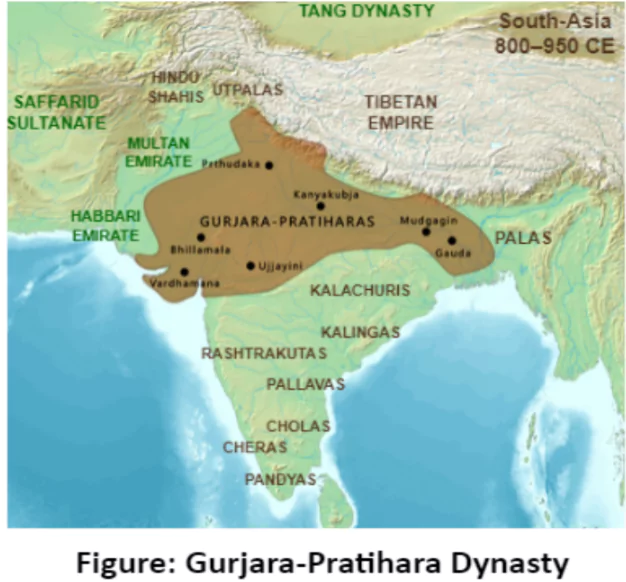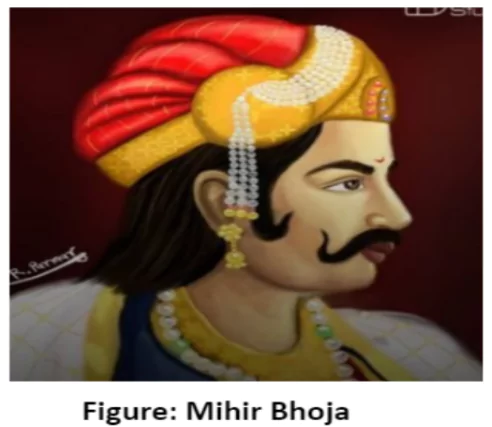Introduction
The Gurjara Pratiharas, also known as Agnikula Rajputs, established a powerful dynasty ruling over Kanauj for centuries. Originating from Gurjaras, they rose to prominence in the 6th century CE, with Nagabhatta I founding the dynasty in Malwa. Their rule saw territorial expansion, notable rulers like Nagabhatta II and Mihir Bhoja, and patronage of arts and literature.
Overview Gurjara-Pratihara Dynasty: Rise, Expansion, and Cultural Flourishing
1. The emergence of the Gurjara-Pratihara Dynasty:

- Origin and Identity of the Pratiharas: The Pratiharas, also known as Gurjara-Pratiharas, ruled over Kanauj for a long time and originated from the Gurjaras, pastoralists similar to the Jats.
- They established principalities in central and eastern Rajasthan and were believed to be descendants of Lakshamana from the Ramayana or a branch of the Gurjara race.
- Epigraphic Evidence: including the Aihole inscription of Pulakesin II and records of Hieun Tsang, traces the Pratiharas’ origin to the Gurjara stock.
- Scholarly Debate: Some scholars suggest that Gurjaras were central Asiatic nomads or indigenous to India, while others propose they were from the Gurjaradesa region.
- Rise to Prominence: The Gurjaras rose to prominence in the 6th century CE, taking advantage of the Gupta Empire’s decline.
- Harichandra: The Gurjara Pratihara dynasty was established by Harichandra, with their origins believed to be from Ujjain or Mandsaur.
Enroll now for UPSC Online Course
2. Important Rulers
- Nagabhatta I (730-760 AD) and Vatsaraja (780-800 AD) expanded their territories significantly, including regions of Rajasthan, Malwa, and Gujarat.
- Capital: Nagabhatta’s capital was at Awani, and his realm covers Bharuch, Gwalior, and Malwa.
- Challenges and Expansion: He successfully resisted Arab encroachments into Rajasthan, Gujarat, and Punjab, defeating them decisively in Gujarat in 738.
- However, efforts to extend control over the upper Ganga valley and Malwa were thwarted by Rashtrakuta rulers.
- Territorial Establishment: Nagabhatta I established an empire from Gujarat to Gwalior, resisting Arab invasions further east of Sindh.
- His Successors: Kakkuka and Devaraja, inherited this empire, although conflicts with Rashtrakutas continued.
- Nagabhatta II (800-833 AD), Vatsraj’s son, revived the dynasty and his suzerainty was recognised by rulers of western Kathiawar, Andhra, Kalinga and Vidarbha.[UPSC 2022]
- He attacked Kannauj which led to the conflict with Dharmapala. Dharmapala sought assistance from Rashtrakuta king, Govinda III (794-813 AD) which led to the defeat of Nagabhatta II.
 Mihir Bhoja (836-885 AD), around 836 AD marked a pivotal point in Pratihara fortunes. [UPSC 2022]
Mihir Bhoja (836-885 AD), around 836 AD marked a pivotal point in Pratihara fortunes. [UPSC 2022]-
- Bhoja consolidated a vast empire stretching from Punjab and Kathiawar to Koshal and Kanauj, with several contemporary powers acknowledging his suzerainty.
- He was a devotee of Vishnu and took the title of ‘Adi Varaha’.
- Bhoja’s son Mahendrapal (AD 885-910) extended the empire further by adding Magadh and parts of North Bengal.
- Extent/Conquest: They captured a large part of Madhyadesh and Kanauj by the 9th century.
- Initially ruling from Bhilmal, they subsequently shifted their capital to Kanauj
- The Pratiharas were noted for their opposition to Arab forces and their strategic conflicts with the Palas and the Rashtrakutas.
3. Decline of Gurjara Pratihara Dynasty
- Subsequent Weaker Rulers: couldn’t maintain the vast empire, facing assaults from the Rashtrakutas.
- The Emergence of New Kingdoms: The decline paved the way for the rise of several new kingdoms like the Chalukyas, Chandellas, Chahmanas, Gahadawalas, Paramaras, Kalachuris, Tomars and Guhilas, which became independent as distinct Rajput clans in their own territories.
Enroll now for UPSC Online Classes
Conclusion
The Gurjara Pratiharas left a significant mark on Indian history through their enduring rule, territorial conquests, and cultural patronage. Though facing eventual decline due to external pressures, their legacy lives on through their architectural marvels, literary contributions, and role in shaping the religious landscape of medieval India.
![]() May 14, 2024
May 14, 2024
![]() 5080
5080
![]() 0
0

 Mihir Bhoja (836-885 AD), around 836 AD marked a pivotal point in Pratihara fortunes. [UPSC 2022]
Mihir Bhoja (836-885 AD), around 836 AD marked a pivotal point in Pratihara fortunes. [UPSC 2022]